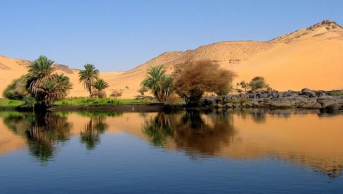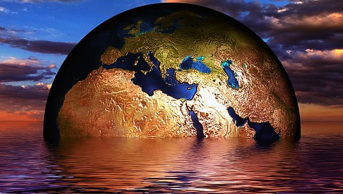Water is what states make out of it: On water efficiency challenge in the Middle East and how it is related with peace and stability in the region

It is not only economically rational,but at at he same time politically difficult to raise the issue of water efficiency. While this is even so in the most advanced economies, for many Middle Easterners water efficiency directly resonates “expensive water”. This dilemma, the necessity and the difficulty embedded in increasing the efficiency of water use can only be handled with a composite strategy in which incremental advances will be deemed important.
In a region like the Middle East, creating or accessing to new water resources have increasingly become expensive. Provided that the climate change-related impacts seem to diminish available water resources for nearly all parts of the region, this trend will even become sharper. Thus it is so pressing to make every drop of water count. Instead of resorting to transboundary water resources which may cause tensions in bilateral diplomatic ties (well beyond water paradigm), Middle Eastern countries should seek ways to augment their water availability through utilization of a number of water efficiency technologies, policies and practices. In such a context, efficiency is the easiest way to increase available water in the Middle East where water losses amount up to half of the waters used.
Make every drop count in agriculture:
Agriculture is definitely the first priority area. According to the UN Food and Agriculture Organization (abbreviated as FAO), 60 percent of the water used for irrigation is wasted either via runoff into waterways or evapotranspiration. It should be noted that this is a world-average, and the evaporative losses, in particular, are much higher in the Middle East.
Agricultural water use is around 80 percent for most of the Middle Eastern countries. The world average here is somewhere around 70 percent. Even incremental improvements in this sector will translate into substantial water savings. Water savings in this area will also contribute in fight against desertification, and soil erosion, salinization problem. Successful struggle with these phenomena, in turn, will create a more fertile setting for agriculture. It may even help farmers to produce more crops with less water. Water efficient irrigation methods is the key input here. According to The Broker, a think net on globalization and development, an experimental drip irrigation project run by the “Aga Khan Rural Support Program” in a Syrian village called Fraytan hasreduced the water demandby 30 percent and what is more, increased yields by nearly 60 percent. It continues to state that water efficiency in agriculture sector could be achieved by “growing a diverse array of crops suited to local conditions, especially in drought-prone regions; by practicing agroforestry or growing perennial crops, to build strong root systems and reduce soil erosion; by maintaining healthy soils, either by applying organic fertilizer or growing cover crops to retain soil moisture; and by adopting irrigation systems like“drip” lines that deliver water directly to plants’ roots”. Yet, it should be borne in mind that for these steps to be taken, many farmers in the Middle East need guidance and support. Without public involvement (state support), a shift to a water efficient agriculture in Middle East will remain a wishful thinking.
Do more with less:
EcoMENA, an independent firm providing a wide range of services, reports that “on an average each UAE and Saudi Arabian resident consume 550 liters and 250 liters of water per day respectively. On the other hand, per capita water consumption in United Kingdom and Germany is 150 liters and 127 liters per day respectively.” This example shows the size of wasteful water use in some Middle East countries. Most of the countries in the region hitherto adopted a view that the level of development is positively correlated with consumption. If you are able to consume and practically consume, you can be considered as wealthy. However, this paradigm was discarded in the West/North with the rise of the so-called “green movement”. For several decades or so, the ability to conserve has been the key criterion for development.
Fix that pipe:
Leakages amount to serious water loss in the Middle East. The region’s average is around 40 to 50%. Unfortunately, several countries in the region have become war-torn which have even worsened these figures in the last couple of years. Iraq, Syria, Palestine, Yemen, Libya, are among these countries. Infrastructure repairs are expensive investments that many local politicians tend to ignore given the limited financial resources in the face of a plethora of problems. Again, it will be the central authorities that can take real action in this area. Recently, aids from external donors have been increasingly used by a number of central as well as local governments. However, these are not far from being sufficient in order to struggle with the problem of this size. Last, but not the least, sustained population increases in the region create a tough barrier against fast improvements.
Treat and Reuse
Water treatment is still in infancy for significant parts of the Middle East. Although there are quite advanced examples like oil-rich Gulf countries, and Israel; the overall water treatment capacity in the Middle East is not at a desired level. As FAO reports “Total treated wastewater reused in the Middle East region is 2 663 million m3.” According to same source, “Turkey accounts for 38 percent of the total reused treated wastewater of the Middle East region, followed by the Syrian Arab Republic, Israel and United Arab Emirates with 21, 10 and 9 percent respectively. Saudi Arabia and Azerbaijan each represent 6 percent of the total.” With regard to Syria, these figures were from pre-war period, which have changed tremendously in the last 4.5 years. In brief there is a strong gap between the amount of water that can be treated and that actually treated.
All in all achieving higher degrees of water efficiency is sine qua non for the Middle East countries. There is enormous amount of water in the region that could be saved. Achieving greater efficiency in water use will also relieve the stress over limited transboundary water resources in the region. However, it is equally difficult to achieve water efficiency in this part of the world mainly because of the need of state involvement which can only work well with robust institutional structures; and also because of continued and rampant violence which rendered a number of states totally ineffective.









